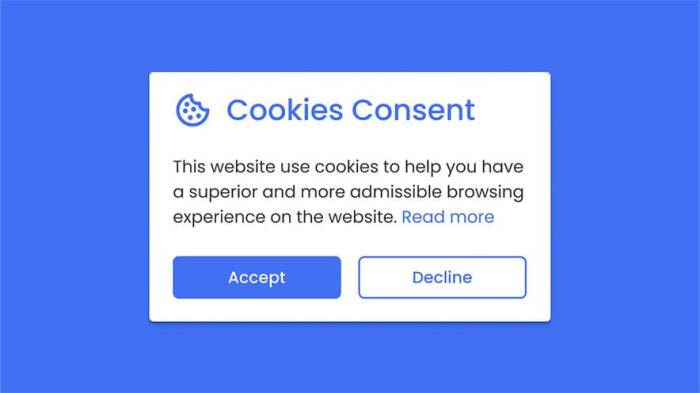
Cookie consent is not enough. We’ve all become accustomed to those pop-up boxes asking us to agree to cookies, but is this really enough to ensure our data privacy in today’s digital world? The truth is, cookie consent forms are often misleading and lack transparency, leaving us vulnerable to data exploitation.
The landscape of data privacy is evolving rapidly, demanding more than just a click of acceptance.
The emergence of regulations like GDPR and CCPA has highlighted the importance of user control over personal information. However, these regulations often focus on cookie consent as a primary solution, neglecting the broader context of data collection and use.
This creates a false sense of security, as many users are unaware of the extent to which their data is being tracked and analyzed. As public awareness of data privacy concerns grows, it’s clear that we need to move beyond cookie consent and adopt more comprehensive and transparent approaches.
The Limitations of Cookie Consent
Cookie consent mechanisms, though intended to empower users, are not without their limitations. While they offer a degree of control over data collection, their effectiveness is often hampered by various factors, including the complexity of the consent process, the potential for misleading or deceptive practices, and the ease with which consent can become a mere formality.
The Complexity of Cookie Consent Forms, Cookie consent is not enough
The complexity of cookie consent forms can significantly hinder informed decision-making. Users are often presented with long lists of cookies and their purposes, with little context or explanation. This can be overwhelming and confusing, making it difficult for users to understand the implications of their choices.
We’re all bombarded with cookie consent pop-ups these days, but let’s be real – clicking “accept” doesn’t actually tell us what’s happening with our data. It’s just the first step in a much larger conversation about privacy. That’s why I’m fascinated by the bold chatbot David Byttow’s secret – a project aimed at giving users more control over their online identity.
Maybe it’s a sign that the future of privacy is about empowering individuals, not just ticking boxes on cookie banners.
For instance, a typical consent form might list dozens of cookies with cryptic names like “analytics.js” or “session_id,” without providing clear information about their specific functions or data collection practices.
Misleading or Deceptive Practices
Cookie consent forms can be misused to mislead or deceive users. For example, some websites may pre-select all cookies by default, requiring users to actively opt-out of data collection. This can create the illusion of consent, even when users may not have fully understood the implications of their choices.
Sure, cookie consent is a good first step, but it’s not enough. We need to be more proactive in protecting our data. For example, instead of buying expensive wallpaper, why not try a stamped star wall DIY money-saving wallpaper alternative ?
It’s a fun and creative way to personalize your space while also saving money. Just like with data privacy, a little DIY can go a long way.
Other deceptive practices include using ambiguous language or framing consent options in a way that favors data collection.
It’s easy to feel like we’re making progress with cookie consent pop-ups, but we’re really just scratching the surface. We need to go beyond the basics and start supporting real change, like championing businesses that are making a difference.
Check out this amazing resource, 100 black owned kids shops , and see how your online choices can help build a better future. Just like cookie consent, we need to be intentional about who we support and how we spend our money.
Consent as a Mere Formality
In some cases, cookie consent can become a mere formality. Users may be accustomed to clicking “accept” or “continue” without carefully reading the consent forms, simply to access the website content. This can lead to a situation where users are giving consent without fully understanding the implications, effectively rendering the consent process ineffective.
For example, many websites use “cookie walls,” where users are prevented from accessing the website content unless they agree to all cookies. This can create a sense of urgency and pressure, leading users to accept without fully understanding the consequences.
Beyond Cookie Consent
Cookie consent banners, while a step in the right direction, are often inadequate in truly protecting user privacy. The limitations of consent mechanisms, such as their complexity and lack of transparency, have led to a search for alternative approaches to data privacy.
This has paved the way for a new wave of privacy-enhancing technologies (PETs), which aim to empower users with greater control over their data and foster a more privacy-conscious digital landscape.
Privacy-Enhancing Technologies (PETs)
PETs are a diverse set of tools and techniques designed to enhance privacy and security in various digital contexts. They are often categorized based on their specific functionalities, such as anonymization, encryption, and differential privacy. These technologies are not limited to cookie management but extend to broader aspects of data collection, processing, and usage.
- Differential Privacy: This technique adds noise to data sets, making it difficult to identify individuals while still allowing for statistical analysis. For example, in a survey on income, differential privacy might add a random amount to each respondent’s income, obscuring individual data while preserving overall trends.
- Homomorphic Encryption: This advanced form of encryption allows computations to be performed on encrypted data without decrypting it, enabling privacy-preserving data analysis. Imagine a hospital analyzing patient data for research without needing to access the actual medical records.
- Federated Learning: This approach allows for training machine learning models on decentralized data without sharing raw data. For example, a mobile device can participate in training a model for spam detection without sending its private messages to a central server.
The Role of Transparency and User Control: Cookie Consent Is Not Enough

The effectiveness of cookie consent mechanisms hinges on the principles of transparency and user control. Users should be fully informed about how their data is collected, used, and shared, and they should have meaningful options to manage their privacy preferences.
This approach not only fosters trust but also empowers users to make informed decisions about their online experiences.
Transparent Data Collection Practices
Transparent data collection practices are essential for building trust and fostering user engagement. When users understand how their data is being used, they are more likely to feel comfortable sharing it.
- Clear and concise explanations: Websites should provide clear and concise explanations of the types of data they collect, the purposes for which they use it, and how long they retain it. This information should be easily accessible and understandable, even for users with limited technical knowledge.
- Transparency about third-party data collection: Websites should be transparent about the third-party services they use to collect data, such as analytics tools, advertising networks, and social media platforms. This information should include the specific types of data collected by each third party, the purposes for which it is used, and the user’s options for opting out of data sharing.
- Data minimization: Websites should collect only the data that is absolutely necessary for their operations. This principle of data minimization helps to protect user privacy by limiting the amount of sensitive information that is collected and stored.
User Interface for Data Control
Providing users with meaningful control over their data is crucial for empowering them to make informed choices about their privacy.
- Customizable cookie settings: Websites should offer users customizable cookie settings that allow them to choose which cookies they accept or reject. These settings should be easily accessible and understandable, and they should be designed to provide users with granular control over their data.
- Data access and deletion options: Users should have the ability to access and delete their personal data that is stored by websites. This right to data portability and erasure is enshrined in regulations like the GDPR and CCPA.
- Simple and intuitive interface: The interface for managing privacy settings should be simple and intuitive, making it easy for users to understand their options and make informed choices.
Clear and Concise Privacy Policies
Clear and concise privacy policies are essential for informing users about how their data is handled.
- Easy to understand language: Privacy policies should be written in plain language that is easily understandable by users, avoiding technical jargon and legalistic phrasing.
- Comprehensive coverage: Privacy policies should cover all aspects of data collection, use, and sharing, including the types of data collected, the purposes for which it is used, the recipients of the data, and the user’s rights.
- Regular updates: Privacy policies should be updated regularly to reflect changes in data practices or legal requirements. Websites should clearly communicate any updates to their privacy policies to users.
The Future of Data Privacy

The landscape of data privacy is rapidly evolving, driven by the relentless march of technology and the increasing awareness of individuals regarding their digital footprints. The emergence of new technologies, such as artificial intelligence (AI), the Internet of Things (IoT), and blockchain, presents both opportunities and challenges for protecting personal data.
The Impact of Emerging Technologies
The impact of emerging technologies on data privacy is multifaceted. AI, for instance, enables sophisticated data analysis, leading to personalized experiences but also raising concerns about bias and potential misuse. The IoT, with its interconnected devices, generates vast amounts of data, creating new vulnerabilities for privacy breaches.
Blockchain, while known for its security features, can also be utilized for data storage and sharing, requiring careful consideration of privacy implications.
Ethical Considerations in Data Collection and Use
Ethical considerations are paramount in data collection and use. The principles of fairness, transparency, and accountability should guide data practices. Data should be collected only for legitimate purposes, with clear consent from individuals. The use of data should be proportionate to the intended purpose, and individuals should have the right to access, correct, or delete their data.
Organizations should be transparent about their data practices and accountable for any breaches or misuse.
Challenges and Opportunities for Responsible Data Privacy
Achieving responsible data privacy in the face of emerging technologies presents significant challenges. One challenge is the increasing complexity of data ecosystems, making it difficult to track and manage data flows. Another challenge is the potential for data breaches and misuse, particularly with the rise of AI and IoT.
However, these challenges also present opportunities. New technologies can be leveraged to enhance data security and privacy, such as through encryption and anonymization techniques. The development of ethical frameworks and regulations can help to ensure responsible data practices.

